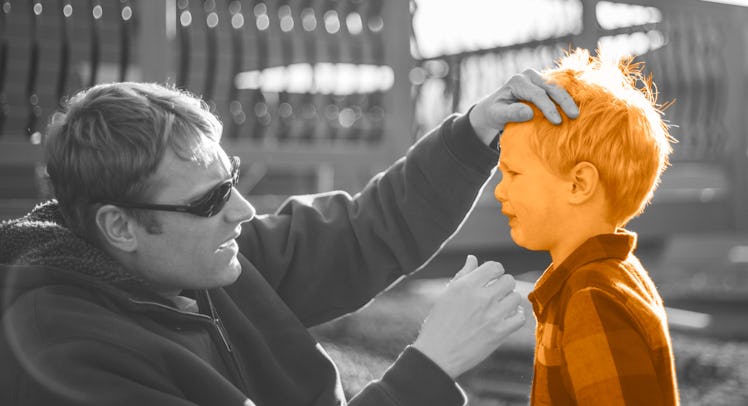How to Calm Down an Injured Child and Teach Bravery
Bumps, bruises, and broken bones are all pretty harrowing the first time they happen. Here’s how parents can coach their kid through the pain.

Kids are permanently set to self-destruct. Toddlers learn new and exciting ways to wipe out every day, and the lack of coordination coupled with a burning desire to go everywhere with gusto can result in abrupt stops on floors and walls. When older kids get involved in sports, whether in an organized league or a disorganized playground, there are myriad ways they can lacerate, bruise, and fracture themselves. Prevention is better than the cure, of course, but accidents can and do happen.
Parents can often cure minor injuries with a handful of colorful Band-Aids and some kindness. When more serious medical intervention is required, however, an ER visit or ambulance ride will require an intelligent game plan to keep a kid calm, reassured, and prepared to get treatment. Parents can help kids in the aftermath of an injury by reacting appropriately and talking through the process of getting it fixed.
“Saying ‘don’t be afraid’ has not, in the history of mankind, ever helped anyone not feel afraid,” says Dr. Jaelyn Farris, a psychology professor conducting developmental psychology research at Youngstown State University.
What might seem like a minor injury to a parent can seem a lot worse to a child who doesn’t have a lot of experience with pain. “A lot of us parents, if it is not that serious of an injury, will say to them ‘it’s not that big of a deal, get back into the game,’ and I think that confuses kids,” Farris says. “Their body is telling them that it hurts and their brain is telling them they’re scared.”
Sometimes, an injury can put enough fear in kids to deter them from participating in an activity they enjoy. Human beings learn how to do complex things by trying, failing, learning from mistakes, and trying again and again until they are successful. Getting back into the fray, then, is important—but it shouldn’t be rushed.
“Parents want kids to get back on the proverbial horse so they are not afraid of the activity forever, but pushing them back into it before they are ready can cause a lot of stress,” Farris says. “Follow their lead. Wait until they’re ready to get back into the game or activity and encourage them when they have the confidence to return to it.”
How to Deescalate an Injured Child
- Validate their fears. Their brain is telling them to be scared, and their body is telling them they’re in pain, so don’t dismiss it—even if the injury seems minor.
- Appear in control. Even if your kid can tell you are worried, reassure them by showing them that you know all about the process of fixing their injury.
- Rationalize the steps to recovery. If it’s a simple first-aid fix or a trip to the ER, talking through every step before it happens will help remove fear of the unexpected.
- Follow their lead. It’s tempting to immediately push them back into the game or sit them back on the bike right away but be patient and help them recover their confidence at their own pace.
If an injury requires some actual professional medical intervention—a broken limb, or a concussion, or a laceration that needs stitches—a lot of things need to happen before normal life can resume. Parents can prepare an injured kid for what lies ahead so that the car or ambulance ride the hospital, the ER waiting room, the X-rays and the uniforms and white coats are all part of a narrative. “Kids haven’t experienced the world a whole lot, so trying to anchor to them what’s going to happen to them can help them deal with a lot of the fear and worry,” Farris says. “A lot of that fear can come from thinking they are going to be taken away from dad or left alone somewhere unknown.”
It is, of course, upsetting for parents to see their kid injured, scared, and in pain. There’s no sense trying to hide those emotions from anyone, Farris says, because children are very, very good at reading emotions. If a child can tell that a parent is worried, but they say that they aren’t, this can add to the kid’s confusion. Instead, Farris says, parents can control those emotions and model bravery. “Show them that being brave doesn’t mean you’re not afraid, it means you’re afraid but you still do what’s needed to fix the situation,” Farris says.
There is an upside to all of this. For kids, dealing with an injury can be a valuable learning experience in terms of building resilience. “Accidents do happen in childhood, and challenges can make us tougher,” Farris says. “It can help kids have more empathy when other children get hurt, and it teaches them that pain can be overcome.”
“It can also teach kids that when dad says, ‘stop jumping off the couch,’ he actually knows what he’s talking about,” Farris adds.